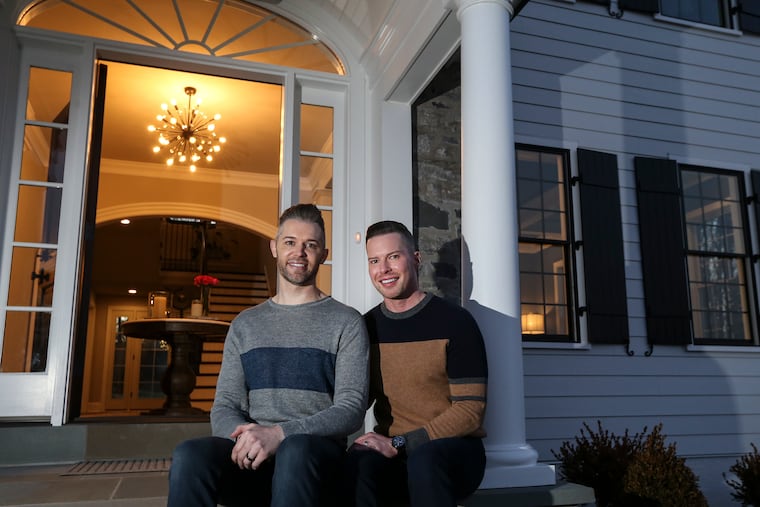Lighting can create a ‘wow factor’ and set different moods in your home
Homeowners have so many lighting options today, in both design and technology. With improvements in LED technology, it’s as simple as clicking your smartphone, or asking Alexa to turn the lights.

The beautiful bronze starburst-shaped Galea chandelier is the first thing you see when you enter Jimmy and Waylon Steele’s Malvern home. That light was an important decision when they built their new house in December.
“We wanted a ‘wow’ factor as soon as you walked in the door,” Jimmy said. “It gives you a fun talking point.”
The couple used lighting to add a modern flair to their farmhouse decor, incorporating different finishes to add pizzazz. Early in the building stage, they consulted with lighting pro Paul Mihranian, president of Lighting by Design in Exton, to plot out where recessed lighting and dimmers would go and to determine the types of fixtures that worked best throughout the home. Their lighting is controlled by Alexa through their Phillips Hue smart home system.
Homeowners have so many lighting options today, in both design and technology. Colorful metals and shades, sconces, and pendants add beauty in addition to function. With improvements in LED technology, it’s as simple as pressing a button, clicking an image on your iPhone, or asking Alexa to turn on your house lights as you pull into the driveway, or turn off selected lights when you go to bed. Local lighting showrooms or smart home integrators can help with setup.
“There have never been more choices in lighting in terms of products and applications,” said Terry McGowan, director of engineering and technology for the American Lighting Association, a residential lighting industry trade association based in Dallas.
“There are always style trends and popular designs,” McGowan said, “but the technical trends tend to be much longer lived and much more important because of the features built into the lighting product, such as dimming, as well as the costs to implement them.”
Lightbulbs, themselves, add a design element, often taking center stage in a fixture. Incandescent bulbs, which had been the standard for decades, have gradually been replaced by LED bulbs, “allowing everything to become smaller, more efficient and longer lasting,” Mihranian said. Kitchen lighting fixtures have earned a more important role recently as homeowners have added huge islands during kitchen renovations.
“They are being driven by the plumbing industry fashion to keep in pace with faucet hardware and kitchen cabinet hardware,” Mihranian said. “A lot are gold and brass, and black is the ultimate neutral, which brings out all the true values of the surrounding colors.”
Homeowners are also straying from traditional ideas. According to the Houzz 2021 Kitchen Trends Study, among the 75% of renovating homeowners who choose to upgrade light fixtures in the kitchen, nearly 1 in 5 chose a chandelier for kitchen lighting.
“Gone are the days of cookie cutter, matchy-matchy,” said Kazan Spratt, owner of Bulb, a lighting shop in Rittenhouse Square specializing in lighting design. “There aren’t as many rules, and everybody’s a designer these days with access to information.”
Natural materials, including wood, distressed finishes, and a recycled look also are popular in lighting. Spratt points to two U.S. companies: Stickbulb, which uses reclaimed wood from water towers, and Graypants, whose Scraplights series is made out of cardboard.
Some homeowners will decide to splurge on a particular fixture for a prominent place in a home where they plan to stay for a long time. Others, Mihranian said, save money by finding a fixture similar to one they loved but without the designer name.
He advises clients to include tiers of light into any space. Ambient lighting is for general viewing, accent lights will highlight important pieces such as artwork, and task lighting makes it possible to work and function in the space.
“You could have four or five switches easily in a kitchen with multiple tiers of light, and putting them on dimmers would give you further control,” Mihranian said.
Recessed lights are now available in smaller sizes, starting at just two inches, limiting the size of holes in the ceiling without giving up the performance of the fixture. They also come in rimless options for a cleaner look.
Replacing a lightbulb can be a daunting task with so many options. With LED bulbs becoming the standard, McGowan recommends three steps in choosing the right LED bulb:
Choose a high-quality bulb. Bulbs with the Energy Star label are independently certified for performance with respect to life, light output, and efficiency.
Determine the color temperature or light appearance that you want. A bulb with a warm, familiar tone, like an incandescent bulb, is rated for 2700 to 2800 Kelvins. A bulb with whiter or bluish-white light has a higher color temperature rating. Bulbs rated for 3000 Kelvins emit a very white light. Look for retail stores where bulbs can be lighted before you buy so you can make the right choice.
Figure out how much light you want from the bulb. Light output (brightness) is measured in lumens. The carton provides all of the bulb’s performance ratings including life, light output, and color.
“If you’re used to buying bulbs by their rated wattage, look for an LED bulb rated for about the same lumens: 40 watts is equivalent to 450 lumens, 60 watts is equivalent to 800 lumens, and 75 watts is equivalent to 1,110 lumens,” McGowan said.
Consult the federal Environmental Protection Agency’s Energy Star program for guidance on choosing a light.